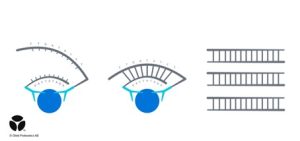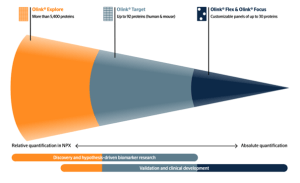
Advanced Technology for Precision Research
Discover cutting-edge tools and solutions designed to revolutionize protein analysis and molecular research. Our technology portfolio combines high-throughput capabilities with exceptional sensitivity, enabling breakthroughs in biomarker discovery and disease research. From Olink® Target panels to Biomark™ HD systems, we offer versatile, scalable solutions to meet the demands of modern science. Explore how our innovative platforms can empower your research with unmatched precision and flexibility.
The unique technology behind Olink® panels technology enables high-throughput, multiplex immunoassays of proteins using minimal volumes of serum, plasma, or almost any other type of biological sample. PEA technology enables high multiplexing levels and sample throughput without compromising on data or assay-robustness.

A highly specific DNA template is created when matched oligo-linked Ab pairs bind to a protein.
Using PEA, our panels can provide accurate quantification below pg/mL levels even in small samples from, for example, needle biopsies or micro dialysis. This minimal sample consumption makes our precision proteomics solution especially suitable for retroactively mining precious biobanked serum samples for new multivariate biomarker signatures. Fully validated in serum & plasma, PEA is also compatible with a wide range of different sample types.

Olink Explore series offers high-throughput proteomics, analysing thousands of proteins simultaneously with exceptional specificity and scalability, enabling advanced disease research and biomarker discovery.
Next-level proteomics with uncompromised performance. Measure 5,400+ proteins with proven specificity to gain an understanding of disease at the protein level.
Realize any project you can imagine. Olink Explore HT is designed for outstanding performance at any scale of protein biomarker discovery, from pilot investigations with a few hundred samples to the largest population studies with biobank cohorts.
Measure ~5,400 protein biomarkers with industry-leading specificity. With the launch of Olink Explore HT, the assay library was significantly expanded with nearly 2 500 new assays compared to Explore 3072, bringing the total number to more than 5 400 assays. Explore HT has extensive coverage of inflammatory and immune response-related proteins, secreted proteins, drug targets, disease-associated proteins, and canonical plasma proteins.
Modular high-multiplex biomarker discovery with uncompromised data quality.
Olink Explore 3072 library consists of eight disease- and biological process-focused 384-plex panels. Providing a flexible and efficient solution for larger scale targeted investigations. The assays available in these panels include biomarkers that contribute the most to key research questions and cover many key biological pathways and functions; Cardiometabolic, Inflammation, Neurology and Oncology. Five main categories of proteins were defined during target selection, and each assay can be classified into one or more of these categories.
A Powerful, NGS-based proteomics with more than 1000 proteins – uncovering meaningful insights.
The protein selection strategy focuses on actionable, druggable, robustly detected circulating proteins with broad proteome coverage, particularly those involved in inflammation and immune response, drawn from protein annotations, publications, approved therapies, and researcher requests.
Each panel is focused on a specific area of disease or key biology process, targeting 92 established and/or exploratory biomarkers. All assays are rigorously quality controlled, and our validation data is made freely available. Currently there are six disease area-focus panels available: two for cardiovascular disease (Olink Target 96 Cardiovascular II and Olink Target 96 Cardiovascular III), two for oncology (Olink Target 96 Oncology II and Olink Target 96 Oncology III), as well as Olink Target 96 Neurology, Olink Target 96 Inflammation and Olink Target 96 Immuno-oncology. These are complemented by seven panels, focused on important biological processes: Olink Target 96 Cardiometabolic, Olink Target 96 Cell Regulation, Olink Target 96 Development, Olink Target 96 Immune Response, Olink Target 96 Metabolism, Olink Target 96 Neuro Exploratory and Olink Target 96 Organ Damage. For researchers working with mouse models, Olink Target 96 Mouse Exploratory is also available.
Olink Target 48 Human or Mouse Cytokine and Immune Surveillance panels as well as the Mouse Cytokine panel, is the ultimate solution for cytokine studies and inflammation-related diseases. The thorough selection of biomarkers ensures that the most important proteins covering key pathways related to cytokine signaling and inflammatory processes are well covered.
Target 48 Cytokine and Immune Surveillance panels as well as the Mouse Cytokine panel enables analysis of 45 carefully selected proteins across 40 samples simultaneously from just 1 µL sample. In comparison to other products for multiple cytokine analysis, this panels offers superior sensitivity, specificity and dynamic range. Absolute quantification in standard concentration units (pg/mL) via provision of calibrators for each assay (first time this is available in a standard Olink panel) Each analyte in the panel has been validated in terms of specificity, precision, sensitivity, dynamic range, matrix effects and interference.
Olink® Flex is a customizable made-to-order product that enables the selection and combination of up to 21 human proteins into a single protein biomarker panel. Freely mix and match from ~200 pre-validated assays covering major disease areas. Olink® Flex panels offer mid-plex proteomics with unequaled flexibility and absolute quantification to cover a wide range of needs.
Mix and match 5 – 30 pre-validated assays from an extensive Olink library across 40 samples simultaneously from just 1 µL sample. Each assay maintains the quality, performance, specificity, and sensitivity that our other products are known for. Our internal controls remove the need to run replicate samples, and the data is reported in absolute (pg/mL) or relative (NPX) quantification.